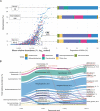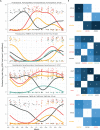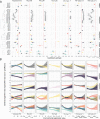Seasonal niche differentiation among closely related marine bacteria
- PMID: 34285363
- PMCID: PMC8692485
- DOI: 10.1038/s41396-021-01053-2
Seasonal niche differentiation among closely related marine bacteria
Abstract
Bacteria display dynamic abundance fluctuations over time in marine environments, where they play key biogeochemical roles. Here, we characterized the seasonal dynamics of marine bacteria in a coastal oligotrophic time series station, tested how similar the temporal niche of closely related taxa is, and what are the environmental parameters modulating their seasonal abundance patterns. We further explored how conserved the niche is at higher taxonomic levels. The community presented recurrent patterns of seasonality for 297 out of 6825 amplicon sequence variants (ASVs), which constituted almost half of the total relative abundance (47%). For certain genera, niche similarity decreased as nucleotide divergence in the 16S rRNA gene increased, a pattern compatible with the selection of similar taxa through environmental filtering. Additionally, we observed evidence of seasonal differentiation within various genera as seen by the distinct seasonal patterns of closely related taxa. At broader taxonomic levels, coherent seasonal trends did not exist at the class level, while the order and family ranks depended on the patterns that existed at the genus level. This study identifies the coexistence of closely related taxa for some bacterial groups and seasonal differentiation for others in a coastal marine environment subjected to a strong seasonality.
© 2021. The Author(s).
Conflict of interest statement
The authors declare no competing interests.
Figures





References
-
- Fuhrman JA, Cram JA, Needham DM. Marine microbial community dynamics and their ecological interpretation. Nat Rev Microbiol. 2015;13:133–46. - PubMed
-
- Falkowski P. Ocean science: the power of plankton. Nature. 2012;483:S17–20. - PubMed
-
- Bunse C, Pinhassi J. Marine bacterioplankton seasonal succession dynamics. Trends Microbiol. 2017;25:1–12. - PubMed
-
- Buttigieg PL, Fadeev E, Bienhold C, Hehemann L, Offre P, Boetius A. Marine microbes in 4D-using time series observation to assess the dynamics of the ocean microbiome and its links to ocean health. Curr Opin Microbiol. 2018;43:169–85. - PubMed

